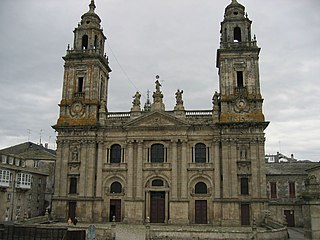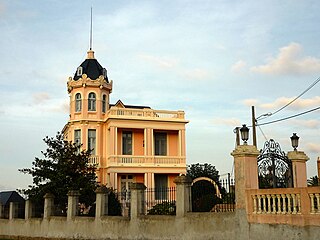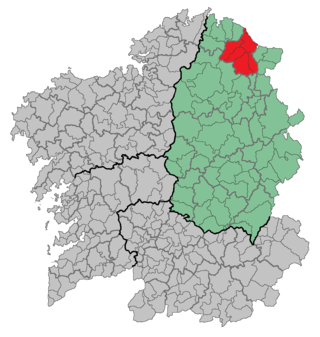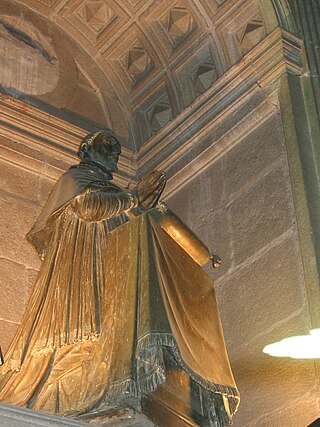This article needs additional citations for verification .(July 2023) |

Castrodouro Castle is a small fortification in Alfoz, Galicia, Spain, who once belonged to Pardo de Cela's family. Of the primitive castle, only the keep is preserved. [1] [2]
This article needs additional citations for verification .(July 2023) |

Castrodouro Castle is a small fortification in Alfoz, Galicia, Spain, who once belonged to Pardo de Cela's family. Of the primitive castle, only the keep is preserved. [1] [2]
The origin of the castle dates back to a monastery founded in the 9th century by a family from Castile. Part of the Diocese of Mondoñedo, it was later fortified with the support of the Asturian monarchy. In the 15th century it passed into the hands of Marshal Pedro Pardo de Cela, as a dowry for his wedding with Isabel de Castro, niece of Bishop Pedro Enrique de Castro.
When in December 1483 Pedro Pardo de Cela was beheaded by order of the Catholic Monarchs, it returned to the property of the Diocese of Mondoñedo, then ruled by Bishop Diego Soto Valera. He converted it into an episcopal residence, a function it maintained until the 17th century, when it was abandoned.
Since the 19th century it has belonged to the Alfoz municipality, and was used for most of the 20th century as the town hall and the Municipal Court. Nowadays it houses the Alfoz visitor centre and a museum. [2]

Andrade is a surname of Galician origin, which emerged in the 12th century as the family name of the knights and lords of the small parish of San Martiño de Andrade, in the municipality of Pontedeume. The first mention of this small territory is to be found in the documentation of the monastery of San Xoán de Caaveiro, and belong chronologically to the 9th century. It was part of the region of Pruzos, which was created as an administrative and ecclesiastical territory of Kingdom of Galicia in the sixth century by King Teodomiro through a document written in Latin called Parrochiale suevum, Parochiale suevorum or Theodomiri Divisio. From the 12th century Pruzos, and therefore Andrade, were integrated into the county of Trastámara that belonged to the lineage Traba, the most powerful Galician family. By this same time the family group: Fortúnez, begins to unite their names Andrade as surname, since in this parish their family home was located. The knights of Andrade were faithful vassals of their lords the Counts of Trastámara throughout the middle centuries of the Middle Ages.

Mondoñedo is a small town and municipality in the Galician province of Lugo, Spain. As of 2009, the town has a population of 4,508. Mondoñedo occupies a sheltered valley among the northern outliers of the Cantabrian Mountains. Despite being the core of the region of A Mariña Central, it is the city with the fifth biggest population after Viveiro, Ribadeo, Foz and Burela.

The Diocese of Mondoñedo-Ferrol is a Latin diocese of the Catholic Church in Spain. It is the northernmost of the four suffragan dioceses in the ecclesiastical province of the Metropolitan Archdiocese of Santiago de Compostela, which covers Galicia in the northwest of Spain. The area had previously been home to Britonia, a settlement founded by expatriate Britons in the wake of the Anglo-Saxon invasion of Britain. Britonia was represented by the diocese referred to as Britonensis ecclesia in sources from the 6th and 7th centuries.

The Archdiocese of Santiago de Compostela is a Latin Church archdiocese of the Catholic Church in Spain. It is the senior of the five districts in which the church divides Galicia in North-western Spain.

The Roman Catholic Diocese of Lugo is a Latin Church see of the Catholic Church within Galicia, in north-western Spain, and one of the four suffragans in the ecclesiastical province of the Metropolitan Archdiocese of Santiago de Compostela.

The Diocese of Ourense is one of five Latin Church dioceses of the Catholic Church in Galicia, northwestern Spain. The Bishop of Ourense has his cathedra in the Catedral de la Virgen Madre de los Milagros in Ourense and his jurisdiction covers all the 28 districts and 735 parishes of the Province of Ourense.

Alfoz is a municipality in the province of Lugo, in the autonomous community of Galicia, Spain. It is in the comarca of A Mariña Central. It borders the municipalities of Foz, Mondoñedo, Abadín and O Valadouro.

Foz is a town and municipality in the A Mariña Central comarca in the Galician province of Lugo. It has been historically linked to the Ancient Province of Mondoñedo and also linked to the arrival of Briton immigrants during the Dark Ages fleeing by sea from the British Isles. It has 9800 inhabitants. It borders the coastal municipalities of Burela and Barreiros, and the inland municipalities of Lourenzá, Mondoñedo, O Valadouro, Alfoz, and Cervo.

Barreiros is a municipality in the province of Lugo, in the autonomous community of Galicia, Spain. It belongs to the comarca of A Mariña Oriental. This municipality is closely linked to the history of the province from pre-Roman times. It has a geographical range extending from the valleys to the mountains and from the plains to the coast with high cliffs and long beaches.

A Mariña Central is a comarca in the Galician Province of Lugo. The overall population of this local region is 28,955 (2019). This region is a political-administrative division of A Mariña de Lugo macro-region. To the north and northeast the region borders the Bay of Biscay, on the northwest with La Mariña, to the west and south by the Terra Chá, Meira on the southeast and east with A Mariña Oriental.

A Pastoriza is a municipality in the province of Lugo, in the autonomous community of Galicia, Spain. It belongs to the comarca of Terra Chá. It has a population of 3,911 and an area of 175 km². The most important river in Galicia and one of the most plentiful rivers of Spain begins here, the Miño River.

The Diocese of Guadix is a Latin suffragan diocese of the Catholic Church in the ecclesiastical province of Granada in Andalusia, southern Spain and a Latin titular bishopric under its Ancient name of Acci. Its cathedral episcopal see is Nuestra Señora de la Anunciación, dedicated to Our Lady of the Annunciation, in the city of Guadix, administrative province of Granada. It was commenced in 1710, on the site occupied by the principal mosque, and completed in 1796.

The Diocese of León is a Latin Church diocese of the Catholic Church located in the city of León in the ecclesiastical province of Oviedo in Spain.
Saint Gonzalo (or Gundisalvus) (c. 1040 – c. 1108), a medieval Galician nobleman and clergyman, was the long-serving Bishop of Mondoñedo from 1071. According to one modern source he was a brother of Pedro Fróilaz de Traba. If he was elected at the canonical age of thirty, he would have been born in 1040 or 1041, which would in turn support the contemporary contention that he was old in 1104–5, but cast doubt on his relationship with Pedro Fróilaz. Perhaps he was a more distant relative of the same family, the budding House of Traba.
Enrique Cal Pardo was a Spanish Galician priest, teacher and writer. He was born in Galdo, Viveiro, (Galicia).

Rodrigo de Castro Osorio, was Cardinal-Bishop of Zamora (1574–1578) and Diocese of Cuenca (1578–1581), Archbishop of Seville, (1581–1600), a member of the Council of State of Spain and the Supreme Council of the Spanish Inquisition for the reign of Philip II of Spain. Great-uncle of Pedro Fernández de Castro y Andrade, Conde de Lemos. He was closely linked to the city of Monforte de Lemos in Galicia, where he was the founder of the College of Our Lady of Antigua.

Pedro Pardo de Cela Rodriguez de Aguiar e Ribadeneyra was a fifteenth century Marshal of Galicia, son of Joam Nunes Pardo, senhor da Torre Cela and Dona Teresa Rodriguez de Aguiar.

The Basilica of San Martiño de Mondoñedo is a church in the municipality of Foz in Galicia (Spain). It is considered the oldest cathedral in Spain; it was the seat of two bishops in the ninth century.

The Co-Cathedral of Saint Julian is a Roman Catholic church in the town of Ferrol in the autonomous community of Galicia, Spain.
Rodrigo Gómez de Traba, also called Ruy Gómez de Trastámara, was a Galician nobleman of the House of Traba.